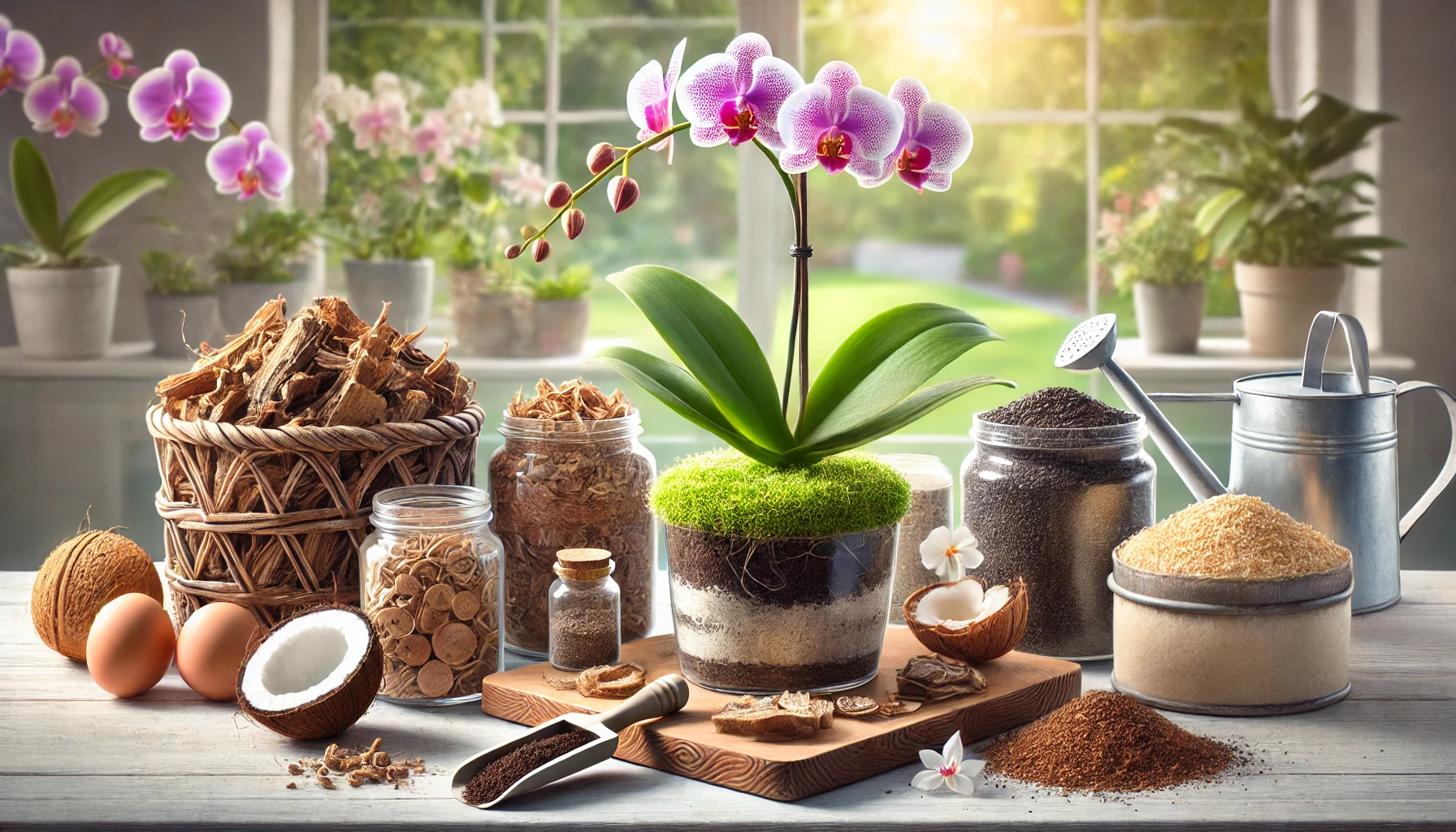Orchids are unique plants that require a specialized potting mix to thrive. Unlike typical houseplants that grow in soil, orchids have aerial roots that need proper air circulation, drainage, and moisture control. Choosing the right potting mix is essential for preventing root rot, ensuring good hydration, and promoting healthy growth.
🌱 Why Orchids Need a Special Potting Mix
Orchids grow differently from most plants. In their natural habitat, they attach themselves to trees, rocks, or other surfaces rather than growing in soil. Their roots absorb moisture from the air and rain while remaining exposed to oxygen. Because of this, orchids cannot survive in regular potting soil, which holds too much moisture and suffocates the roots.
✔ Benefits of a Proper Orchid Potting Mix:
- Provides good airflow to prevent root suffocation.
- Retains enough moisture without staying soggy.
- Supports the orchid’s roots, allowing them to anchor securely.
- Prevents common issues like root rot and fungal infections.
❌ Problems Caused by the Wrong Potting Mix:
- Poor drainage leads to overwatering and root rot.
- Lack of aeration causes suffocated roots and weak growth.
- Dense or compacted medium prevents nutrients and water from reaching roots.
💡 A good orchid potting mix mimics the plant’s natural environment—light, airy, and moisture-balanced!
🌿 Types of Orchid Potting Mix Components
Different orchid species have different moisture and airflow needs. The best potting mix for your orchid will depend on its natural habitat and growth habits. Here are the most common potting materials used for orchids:
🌲 Bark Chips (Best for Most Orchids)
✔ Provides excellent airflow for roots.
✔ Drains quickly, reducing the risk of root rot.
✔ Mimics the natural environment of epiphytic orchids like Phalaenopsis and Cattleya.
✔ Needs to be replaced every 1–2 years as it breaks down over time.
🌿 Sphagnum Moss (Best for High Humidity and Water Retention)
✔ Holds more moisture, ideal for orchids that dry out too quickly.
✔ Helps revive dehydrated or rootless orchids.
✔ Can be used alone or mixed with bark for better moisture control.
✔ Must be monitored carefully to avoid overwatering.
🥥 Coconut Husk (Alternative to Bark)
✔ Retains more moisture than bark but still provides good airflow.
✔ Decomposes slowly, lasting longer than sphagnum moss.
✔ Great for orchids in hot, dry climates.
✔ May need to be soaked before use to remove excess salts.
🌱 Perlite (Used for Aeration and Drainage)
✔ A lightweight volcanic rock that improves air circulation.
✔ Prevents potting mix from becoming too compact.
✔ Often mixed with bark or moss for better root growth.
🔥 Charcoal (Keeps Potting Mix Fresh)
✔ Helps absorb impurities and excess salts from fertilizers.
✔ Prevents fungal growth and keeps the mix fresh longer.
✔ Best used as part of a mix, not on its own.
💡 Combining different potting materials allows you to create the perfect mix for your specific orchid!
🏺 Choosing the Right Potting Mix for Your Orchid Type
Not all orchids have the same water and airflow requirements. Some prefer a dry, well-draining mix, while others need more moisture retention.
✔ Best Potting Mix for Phalaenopsis Orchids (Moth Orchids)
- 75% bark chips + 25% sphagnum moss or perlite
- Provides good drainage with some moisture retention.
✔ Best Potting Mix for Cattleya Orchids
- 80% bark chips + 10% charcoal + 10% perlite
- Needs excellent drainage and aeration.
✔ Best Potting Mix for Dendrobium Orchids
- 60% bark chips + 30% coconut husk + 10% perlite
- Retains moderate moisture while allowing airflow.
✔ Best Potting Mix for Oncidium Orchids
- 50% bark chips + 50% sphagnum moss
- Holds more moisture, as Oncidiums prefer slightly damp conditions.
✔ Best Potting Mix for Vanda Orchids
- Large bark chunks or coconut husk alone
- Vandals are usually grown in hanging baskets, needing maximum airflow.
💧 How to Prepare and Repot an Orchid with Fresh Potting Mix
Repotting is necessary every 1–2 years to prevent the potting mix from breaking down and becoming too dense.
🛠 Step-by-Step Guide to Repotting with Fresh Potting Mix:
1️⃣ Remove the Orchid from Its Old Pot:
✔ Gently shake off the old potting mix, being careful not to damage roots.
2️⃣ Inspect the Roots:
✔ Trim any dead, black, or mushy roots using sterilized scissors.
3️⃣ Choose the Right Pot:
✔ Select a pot with drainage holes to allow excess water to escape.
4️⃣ Prepare the Potting Mix:
✔ Soak bark chips or coconut husk in water for 30 minutes before use.
✔ If using moss, keep it lightly damp, not soaking wet.
5️⃣ Place the Orchid in the New Pot:
✔ Position the plant so that roots are naturally spread out.
✔ Fill with fresh potting mix, leaving space for air circulation.
6️⃣ Water Lightly and Let the Orchid Adjust:
✔ Avoid overwatering—wait a few days before watering deeply.
✔ Keep the orchid in a stable environment with indirect light.
🚫 Common Potting Mix Mistakes to Avoid
❌ Using regular soil – Compacts around roots, suffocating them.
❌ Packing the mix too tightly – Prevents air circulation, leading to rot.
❌ Not replacing old mix – Decomposed materials hold too much water.
❌ Overwatering fresh mix – Newly repotted orchids need time to adjust.
🛡 Final Tips for Choosing the Best Orchid Potting Mix
✔ Choose a well-draining mix that suits your orchid type.
✔ Mix different materials to balance airflow and moisture retention.
✔ Repot every 1–2 years to refresh the growing medium.
✔ Keep orchids in a stable environment to prevent stress after repotting.
✔ Monitor root health—healthy roots lead to better hydration and stronger growth.
By selecting the right potting mix, your orchid will develop healthy roots, vibrant leaves, and stunning blooms for years to come! 🌸✨
